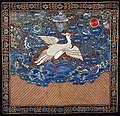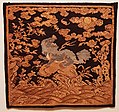User:MPCostumes/sandbox
Dear Team Mandarin Square
You did an excellent job. I like that you added information through out the article and that you linked to outside resources and cited from a variety of sources. I predicted that your changes and additions will "stick" without correction or major edit.
A mandarin square (traditional Chinese: 補子; simplified Chinese: 补子; pinyin: bŭzi; Wade-Giles: putzŭ; Manchu: sabirgi; Vietnamese: Bổ Tử; hangul: 흉배; hanja: 胸背; romanized: hyungbae), also known as a rank badge, was a large embroidered badge sewn onto the surcoat of an official in Imperial China, Korea and Vietnam. It was embroidered with detailed, colourful animal or bird insignia indicating the rank of the official wearing it. The silver pheasant seems to be the most common badge found today because 25% of the people failed to reach the upper ranks of the civil service and stalled at fifth rank.
Yuan Dynasty
[edit]The history of the Mandarin Square is unclear. However, in 事林广记, there are pictures showing officials wearing clothing with squares on the back, decorated with birds. [1]
Ming Dynasty
[edit]
Mandarin squares were first authorized for wear in 1391 by the Ming Dynasty. From the Ming to the Qin Dynasty, the styles of the badges changed dependent on the tastes of the times - not necessarily only when court dress regulations were published in 1652 and revised by Qianlong emperor in 1759. The best indicator of the time period of a badge are background elements such as water and cloud designs, and these could indicate what was fashionable at the time. The use of squares depicting birds for civil officials and animals for military officials was an outgrowth of the use of similar squares, apparently for decorative use, in the Yuan Dynasty.[2] The original court dress regulations of the Ming Dynasty were published in 1368, but did not refer to badges as rank insignia.[3] These badges continued to be used through the remainder of the Ming and the subsequent Qing Dynasty until the imperial system fell in 1912.
Ming nobles and officials wore their rank badges on full-cut red robes with the design stretching from side to side, completely covering the chest and back. This caused the badges to be slightly trapezoidal with the tops narrower than the bottom.[4] The Ming statutes never refer to the number of birds or animals that should appear on the badges. In the beginning, two or three were used. In a typical example of paired birds, they were shown in flight on a background of bright cloud streamers on a gold background. Others showed one bird on the ground with the second in flight. The addition of flowers produced an idealized naturalism.[5][6]
During the Ming Dynasty, Mandarin squares were often made in pairs so they can be worn on both sides of the official’s robe. The square on the front would be split vertically to work with the opening of the garment.[7]
Qing Dynasty
[edit]
Towards the overturning of the Qing Dynasty, military rank badges in particular were burnt to conceal identification
There was a sharp difference between the Ming and Qing styles of badges: the Qing badges were smaller with a decorative border.[8] And, while the specific birds and animals did not change much throughout their use, the design of the squares underwent an almost continual evolution.[9] According to rank, Qing-Dynasty nobles had their respective official clothes. Princes, including Qin Wang and Jun Wang, usually wore black robes as opposed to the blue robes in court, and had four circular designs, one on each shoulder, front, and back, as opposed to the usual front-and-back design. Specifically, princes of the blood used four front-facing dragons, Qin Wang had two front-facing and two side-facing dragons, and Jun Wang had four side-facing ones; all had five claws on each foot. Beile and Beizi had a circular design on their official clothing, the former having two front-facing dragons, the latter two side-facing ones; these dragons had only four claws on each foot, and are referred to as "drakes" or "great serpents" (巨蟒 jù-mǎng). National duke, general, efu, "commoner" duke, marquis and count had two front-facing, four-clawed dragons on square designs, whereas viscount and baron had cranes and golden pheasants, as for mandarins of the first and second class.
-
6th civil rank. Second half of 19th century.
-
3rd civil rank (peacock). Applique. Late 19th or early 20th century.
-
2nd military rank (lion). Late 18th cent.
-
Members of three generations of a lineage are shown in Qing mandarin attire, complete with mandarin squares

Korea
[edit]Korean rank badge (흉배 in Korean) is a small yet beautifully executed panel of embroidery that would have served to indicate the status of a government official in the Choson Dynasty Korea (1392-1910). Made in the nineteenth century, it shows a pair of black and white leopards, one above the other in opposing stance, surrounded by stylised cloud patterns in pink, purple and pale green upon a blue background. It would have been worn by a military official from the first to third ranks. Leopards and tigers, respected for their strength and courage in Korea, were used for the dress of military officials while civil officials wore crane motifs. This badge shows the distinctively spotted animals among rocks, waves and clouds in a pattern which remained virtually unchanged for 300 years.
Religious Symbolism
[edit]Mandarin Squares were often influenced by East Asian diverse religious practices, gods and worship. The Religious influences on the Mandarin Square stemmed from Buddhism, Taoism and Confucianism. Of these beliefs, various sacred symbolism were incorporated into Mandarin squares, often times as a mixture to convey personal preference and the beliefs of the era as the symbols were believed to bring good luck to the wearer.[10]
Of the symbols, the Buddhist held sacred the Eight Buddhist symbols, also known as the Ashtamangala. The symbols include the Parasol representing protection from suffering; the Golden Fish representing general good fortune; the Conch Shell representing the sound of Dharma reaching far and wide; the Lotus representing the true nature of beings who rise through samsara into the beauty and clarity of enlightenment; the Banner of Victory representing the victory of wisdom over ignorance; the Vase representing the teachings of the Buddha; the Dharma Wheel representing the Eightfold Paths; and the Eternal Knot representing dependent origination and the interrelation of all phenomena. [11]
The Taoist held sacred the Eight Immortals of Taoism. The 8 symbols being the Yin-Yang- a way of understanding opposites, Taijitu Shuo a diagram of the supreme polarity which represents all taoist cosmology, The 5 Element chart- representing Earth, fire, wood, water, and metal, BA Gua- which differentiates between supreme and lesser yin and yang, The Lo Pan Compas- multiple rings centered around a magnetic compass used to orient and evaluate land or building sites, He tu & Luo Shu diagrams, Nei Jing Tu, and Guodian Bamboo Strips.[12]
Family Relations
[edit]Children could wear the costumes of the father but no the rank badge as a rule. However, this was often ignored, as seen by this example that has the insignia of a goose for the children of 4th rank civil servants.
Qing regulations specifically authorized wives to wear a square denoting their husband’s rank. Although, the emperor himself had to personally authorize a mandarin to wear a rank, each mandarin had to procure his own squares.
Tables
[edit]Civil rankings were based on the passing of demanding official examinations. Civil badges consisted of nine ranks each represented by different birds, with only a couple of changes of bird types over the two dynasties. Military examinations were based on physical feats rather than literary and the rank badges are rarer.
The specific birds and animals used to represent rank varied only slightly from the inception of mandarin squares until the end of the Qing Dynasty. These tables show this evolution.
Military
[edit]| Rank | Ming (1391–1526) | Ming and Qing (1527–1662) | Late Qing (1662–1911) |
|---|---|---|---|
| 1 | Lion | Lion | Qilin (after 1662) |
| 2 | Lion | Lion | Lion |
| 3 | Tiger or leopard | Tiger | Leopard (after 1664) |
| 4 | Tiger or leopard | Leopard | Tiger (after 1664) |
| 5 | Bear | Bear | Bear |
| 6 | Panther | Panther | Panther |
| 7 | Panther | Panther | Rhinoceros (after 1759)[13] |
| 8 | Rhinoceros | Rhinoceros | Rhinoceros |
| 9 | Rhinoceros | Sea horse[14] | Sea horse[15] |
Scholar
[edit]| Rank | Ming (1391–1526) | Ming and Qing (1527–1662) | Late Qing (1662–1911) | Image |
|---|---|---|---|---|
| 1 | Crane or golden pheasant | Crane | Crane | 
|
| 2 | Crane or golden pheasant | Golden pheasant | Golden pheasant | 
|
| 3 | Peacock or wild goose | Peacock | Peacock | 
|
| 4 | Peacock or wild goose | Wild goose | Wild goose | 
|
| 5 | Silver pheasant | Silver pheasant | Silver pheasant | 
|
| 6 | Egret or Mandarin Duck | Egret | Egret | 
|
| 7 | Egret or Mandarin duck | Mandarin duck | Mandarin duck | |
| 8 | Oriole, quail or paradise flycatcher | Oriole | Quail | 
|
| 9 | Oriole, quail or paradise flycatcher | Quail | Paradise flycatcher[16] |

The official who held a lower position or did odd job used the magpie during the Ming dynasty.
Supervising officials used xiezhi.
Musicians used the oriole.
See also
[edit]- Byzantine dress for the similar "tablion"
- Chinese hat knob
- Hanfu, Gwanbok
- Nine-rank system, for an earlier system for ranking officials in China
Notes
[edit]- ^ "University College London" (PDF). login.ejournals.alumni.ucl.ac.uk. Retrieved 2019-04-15.
- ^ Cammann, Schuyler: Birds and Animals as Ming and Ch'ing Badges of Rank", Arts of Asia (May to June 1991), page 89.
- ^ Cammann, Schuyler: "Development of the Mandarin Square", Harvard Journal of Asiatic Studies Vol VIII, no 2 (1944), pages 75–6.
- ^ Cammann, Schuyler: "Chinese Mandarin Squares, Brief Catalogue of the Letcher Collection", University Museum Bulletin Vol 17, No 3 (June 1953), pages 8–9.
- ^ Cammann, Schuyler: "Chinese Mandarin Squares, Brief Catalogue of the Letcher Collection", University Museum Bulletin Vol 17, No 3 (June 1953), page 9.
- ^ Cammann, Schuyler: "Development of the Mandarin Square", Harvard Journal of Asiatic Studies Vol VIII, no 2 (1944), page 95.
- ^ Major, John (2005). Steele, Valerie (ed.). China: History of Dress. Gale Virtual Reference Library: charles scribner's sons. pp. 260–266.
- ^ Cammann, Schuyler, "Birds and Animals as Ming and Ch’ing Badges of Rank", Arts of Asia (May–June 1991), page 90.
- ^ Jackson, Beverley & Hugus, David, Ladder to the Clouds, Berkeley: Ten Speed Press, 1999, Chapter 15, pages 215–289.
- ^ "Symbols, Chinese Mandarin Squares, Online Exhibits, Exhibits, Spurlock Museum, U of I". www.spurlock.illinois.edu. Retrieved 2019-05-06.
- ^ Religion", Barbara O'Brien Barbara O'Brien is a Zen Buddhist practitioner who studied at Zen Mountain Monastery She is the author of "Rethinking; Guardian, has covered religion for The; Tricycle.org; Outlets, Other. "What Are the Eight Auspicious Symbols of Buddhism? What Do They Mean?". Learn Religions. Retrieved 2019-05-06.
{{cite web}}:|first=has generic name (help) - ^ qigong, Elizabeth Reninger Elizabeth Reninger is a Taoist practitioner of; acupuncture; spirituality, tuina massage She is the author of several books on; including "Physics; Philosophy; Inquiry.", Nondual Spiritual. "Taoist Visual Symbols". Learn Religions. Retrieved 2019-05-19.
{{cite web}}:|first3=has generic name (help) - ^ Note that the rhinoceros is depicted as a buffalo, rather than as a rhinoceros.
- ^ Note that the sea horse is depicted as a horse living under water, rather than as a seahorse.
- ^ Jackson, Beverley & Hugus, David, Ladder to the Clouds, Berkeley: Ten Speed Press, 1999, Table 4, page 133;
- ^ Jackson, Beverley & Hugus, David, Ladder to the clouds, Berkeley: Ten Speed Press, 1999, Table 3, page 133.




